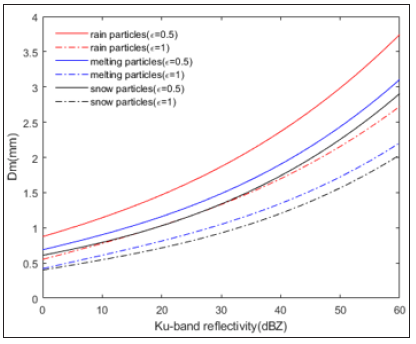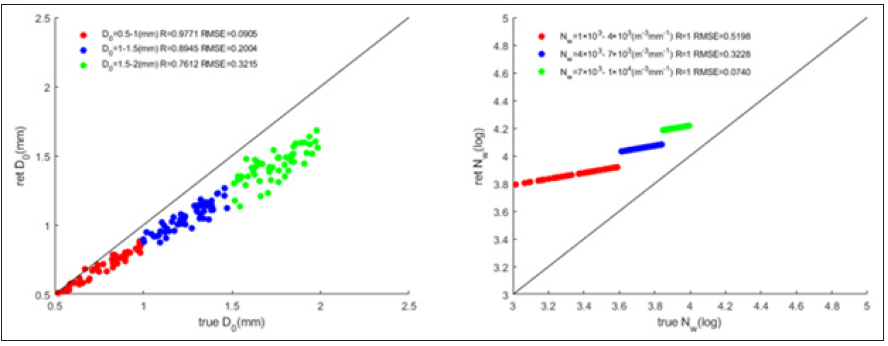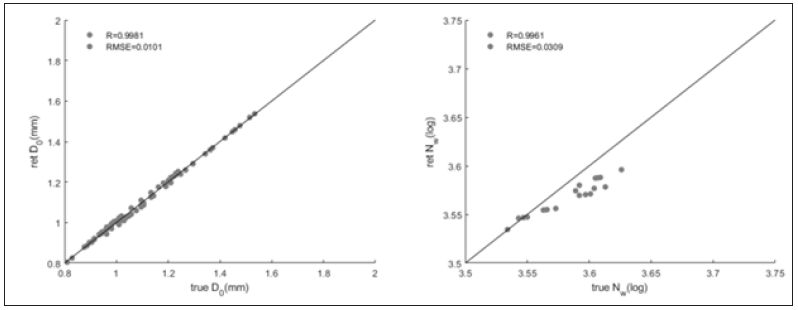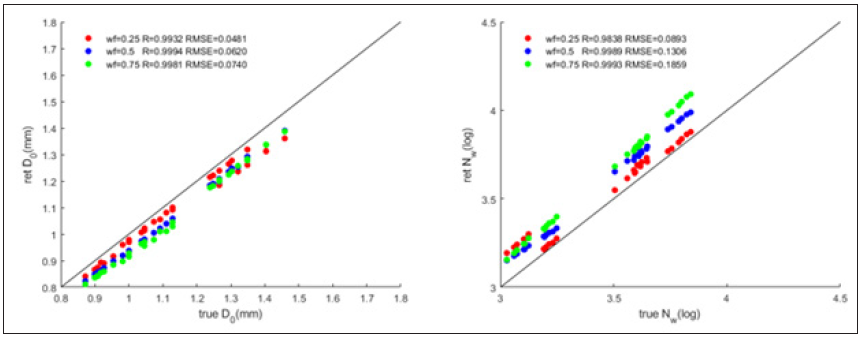- Submissions

Full Text
Novel Research in Sciences
An Analysis on the Retrieval of Raindrop Size Distribution by Dual-Frequency Precipitation Radar
Yuzhen Song, Nan Li* and Danqing Huang
School of Atmospheric Physics, Nanjing University of Information Science and Technology, Nanjing, China
*Corresponding author: Nan Li, School of Atmospheric Physics, Nanjing University of Information Science and Technology, Nanjing, China
Submission: March 3, 2022;Published: March 29, 2022
.jpg)
Volume10 Issue4March, 2022
Abstract
The retrieval of raindrop size distribution has a great significance for the study on the microphysical process of cloud and precipitation, as well as the formation and development of precipitation systems. In this paper, given raindrop size distributions, the T-matrix method is used to simulate the radar detection parameters for solid, mixed and liquid particles, with which the DPR algorithm is used to retrieve the raindrop size distribution to analyze the effect and the sensitivity of the algorithm for different phases. The results show that, for snow particles, when the normalized scale parameter Nw is fixed, the retrieved median diameter D0 is less than the truth value, and the retrieval error increases with the increase of D0; When D0 is fixed, the retrieved Nw is larger than the true value and they have a notable linear relationship. With the increase of the Nw, the retrieval error decreases continuously while the retrieved value changes little. For the rain particles, the retrieval of D0 is very good, and the retrieval of Nw is slightly worse. For the mixed particles, the retrieve D0 is less than the true value, and the retrieve Nw is larger than the true value. The retrieval accuracy increases with the decrease of the mixing ratio.
Keywords: Keywords: Drop size distribution; Dual-frequency radar; Retrieval
Abbreviations: DSD: Drop Size Distribution; PR: Precipitation Radar; GPM: Global Precipitation
Measurement; DPR: Dual Frequency Precipitation Radar
Introduction
In the research field of radar meteorology, it is important to obtain the rain Drop Size
Distribution (DSD) information. The retrieval of DSD is of great significance for the study on
the microphysical process of cloud and precipitation, and on the formation and development
of precipitation systems. It can be also used to analyze the characteristics of precipitation
distribution and to improve the accuracy of radar precipitation estimation. The space borne
radar has a satellite platform of a high orbit and can provide global precipitation observation.
The PR (Precipitation Radar) carried by the TRMM (Tropical Rainfall Measuring Mission) is
the first spaceborne precipitation radar. The Global Precipitation Measurement (GPM) is the
successor to TRMM, and the Dual Frequency Precipitation Radar (DPR) onboard GPM uses
dual frequency technique to detect rainfall.
Ulbrich [1] found that the three parameters of the Gamma distribution (normalized
scale factor Nw, shape parameter μ, and median drop diameter D0) were not independent
of each other and had high Pearson correlation coefficients among them. Zhang et al. [2]
calculated the other two parameters of Gamma distribution by the relationship between
the shape parameters μ and Λ. Seto et al. [3] developed an algorithm to retrieve DSD based
on spaceborne dual-frequency radar, namely the DFR (Dual-Frequency Reflectivity Ratio)
method. Chandrasekar et al. [4] showed that DFR in rain area usually encountered the “double value” problem. In the current DPR algorithm, the relationship
between precipitation rate R and Dm is adjusted by one or several
adjustment factors to eliminate the “double value” problem
when the precipitation rate is small. Liao et al. [5] evaluated the
advantages of dual-frequency algorithm over single-frequency
algorithm in current DPR algorithms. In this paper, the T-matrix
method is used to simulate the radar detection parameters of solid,
mixed and liquid particles when raindrop size distribution is given,
and then the DPR algorithm is used to retrieve the DSD to analyze
the effect of the algorithm for different phases.
Introduction
Particle model
In the study of this paper, rain particles are pure liquid particles, mixed particles are uniformly mixed particles of ice, air and water, and solid particles are uniformly mixed particles of ice and air. The particle density is calculated as in Bohren et al. [6]:

Where, Pw, Pi and Pa respectively represent the percentage of water, ice and air in the whole particle ρw, ρi and ρa respectively represent the densities of water, ice and air, which are fixed as 1g/ cm3, 0.92g/cm3 and 0g/cm3. In this paper, the shape of precipitation particles is oblate ellipsoid, and the relationship between the axial ratio of the oblate ellipsoid and the equivalent diameter is modeled by Brandes et al. [7]. The specific calculation formula is:

where r is the axial ratio of the oblate ellipsoid, and D is the equivalent diameter of the particle. In this paper, it is assumed that: 1) The dual-frequency (Ku and Ka band) radar observes stratiform precipitation; 2) The temperature of the liquid layer is 10 °C; 3) The solid particle density is 0.2g/cm3; 4) The tilt angles of the particles θ satisfy the Gaussian distribution with a mean value of 0 and a variance of 6°; 5) The rotation angles of the particles Φ satisfies satisfy an average distribution of 0°~180°; 6) The particle diameter is 0~8mm.
DSD model
Ulbrich proposed the Gamma distribution to describe the characteristics of DSD [1]. The Gamma distribution includes the concentration parameter N0 (m-3mm-1), the shape factor μ (dimensionless) and the scale parameter Λ (mm-1):

where D is the equivalent volume diameter (mm). In the Gamma distribution, since the unit of N0 is not consistent with the DSD concentration N(D) and has no clear physical meaning, it is not conducive to the retrieval of concentration parameters. Willis proposed a “normalized” Gamma distribution as shown in (4) [8], which introduces the volume median diameter D0 (mm) and normalized scale factor Nw (m−3 mm−1):

In this paper, according to the DPR algorithm, μ is set to 0 in the ice and melting ice regions and set to 3 in the rain region.
The retrieval algorithm of DSD
The current DPR algorithm adds R-Dm relations to constrain the retrieval of DSD. If the Gamma distribution has a fixed shape factor μ or a mass-weighted diameter Dm function, it will have only one parameter Dm.

When the DSD satisfies the Gamma distribution, and μ≥-2, there is a relationship between Dm and D0: (3.67+μ)Dm=(4+μ) D0. According to the analysis of observations by Kozu et al. [9] the values of r,p,q in the current algorithm are 0.401, 6.131 and 4.649 in stratiform precipitation, and 1.370, 5.420 and 4.258 in convective precipitation, respectively [9]. ε ranges from 0.2 to 5, and its optimal value is determined by the minimization of the difference between the simulated and the measured radar reflectivity, and between the calculated and the estimated PIA (the integral attenuation caused by precipitation particles from the surface to the radar). ZKu and Dm are related in a one-to-one pattern when ε is given so that Dm can be uniquely derived from ZKu, and then Nw can be obtained from Dm and ZKu. It can be seen from (Figure 1) that for the same ZKu, Dm (for rain particles)>Dm (formelting particles)>Dm (for snow particles), and Dm decreases as ε increases.
Figure 1: Covid-19 virus trapped in the structure of the FN NANO® coating [2].

The Performance of the DPR Retrieval Algorithm
Because the values of Nw usually have a very large range, they are shown by the logarithmic scale in this study. For the snow particles, As shown in Figure 2, when Nw is fixed and the range of D0 is 0.5mm~1.0mm, 1.0mm~1.5mm and 1.5mm~2.0mm, the retrieved D0 is less than the truth value and the retrieval error increases with the increase of D0; When D0 is fixed and the range of Nw is 1×103m-3mm-1~4×103m-3mm-1 , 4×103m-3mm-1~7×103m-3mm-1 and 7×103m-3mm-1~1×104m-3mm-1, the retrieved Nw is larger than the true value and they have a notable linear relationship. With the increase of Nw the retrieval error decreases while the retrieved value changes little. For rain particles, the DSD parameters in DPR product are taken as the true value. It can be seen from (Figure 3) that the retrieval of D0 is very good and the retrieval of Nw is slightly worse. For the mixed particles, the DSD parameters in DPR product are taken as the true value, and the mixing ratio is set to 0.25, 0.5 and 0.75, respectively. As shown in Figure 4, the retrieved D0 is less than the true value, and the retrieved Nw is larger than the true value. The retrieval accuracy increases with the decrease of the mixing ratio.
Figure 2: The true values of D0 (left) and Nw (right and in log scale) and retrieved values by the DPR algorithm for the snow particles.

Figure 3: The true values of D0 (left) and Nw (right and in log scale) and the retrieved values by the DPR algorithm for the rain particles.

Figure 4: The true values of D0 (left) and Nw (right and in log scale) and the retrieved values by the DPR algorithm for the melting particles with the water fraction of 0.25 (red), 0.5 (blue), 0.75 (green).

Summary and conclusion
In this paper, the T-matrix method is used to simulate the radar
detection parameters of solid, mixed and liquid particles given
the DSD, and then the DPR algorithm is used to retrieve the DSD
based on the radar detection parameters. The retrieval results are
analyzed by comparison with the true values and the conclusions
are as follows:
a. For the snow particles, when Nw is fixed, the retrieved D0
is less than the truth value, and the retrieval error increases with
the increase of D0; When D0 is fixed, the retrieved Nw is larger than
the true value, and the retrieved value and the true value have a
notable linear trend. With the increase of the Nw true value range,
the retrieval error decreases while the retrieved value changes
little.
b. For the rain particles, the retrieval of D0 is very good, and
the retrieval of the Nw retrieve is slightly worse.
c. For the mixed particles, the retrieved D0 is less than the
true value, and the retrieve Nw is larger than the true value. The
retrieval accuracy increases with the decrease of the mixing ratio.
References
- Ulbrich CW (1983) Natural variations in the analytical form of the raindrop size distribution. Journal of Climate and Applied Meteorology 22(10): 1764-1775.
- Zhang G, Vivekanandan J, Brandes EA, Meneghini R, Kozu T (2003) The shape–slope relation in observed gamma raindrop size distributions: Statistical error or useful information. Journal of Atmospheric and Oceanic Technology 20(8): 1106-1119.
- Seto S, Iguchi T, Oki T (2013) The basic performance of a precipitation retrieval algorithm for the global precipitation measurement mission's single/dual-frequency radar measurements. IEEE Transactions on Geoscience and Remote Sensing 51(12): 5239-5251.
- Chandrasekar V, Mubarak K, Lim S (2003) Estimation of raindrop size distribution from TRMM precipitation radar observations. In Geoscience and Remote Sensing Symposium 3: 1712-1714.
- Liao L, Meneghini R (2019) A modified dual-wavelength technique for Ku-and Ka-band radar rain retrieval. Journal of Applied Meteorology and Climatology 58(1): 3-18.
- Bohren CF, Battan LJ (1980) Radar backscattering by inhomogeneous precipitation particles. J Atmos Sci 37(8): 1821-1827.
- Edward BA, Zhang G, Vivekanandan (2002) Experiments in rainfall estimation with a polarimetric radar in a subtropical environment. Journal of Applied Meteorology 41(6): 674-685.
- Willis Paul T (1984) Functional fits to some observed drop size distributions and parameterization of rain. Journal of the Atmospheric Sciences 41(9): 1648-1661.
- Kozu T, Iguchi T, Shimomai T, Kashiwagi N (2008) Raindrop size distribution modeling from a statistical rain parameter relation and its application to the TRMM precipitation radar rain retrieval algorithm. Journal of Applied Meteorology and Climatology 48(4): 716-724.
© 2022 Nan Li. This is an open access article distributed under the terms of the Creative Commons Attribution License , which permits unrestricted use, distribution, and build upon your work non-commercially.
 a Creative Commons Attribution 4.0 International License. Based on a work at www.crimsonpublishers.com.
Best viewed in
a Creative Commons Attribution 4.0 International License. Based on a work at www.crimsonpublishers.com.
Best viewed in 







.jpg)






























 Editorial Board Registrations
Editorial Board Registrations Submit your Article
Submit your Article Refer a Friend
Refer a Friend Advertise With Us
Advertise With Us
.jpg)






.jpg)














.bmp)
.jpg)
.png)
.jpg)










.jpg)






.png)

.png)



.png)






